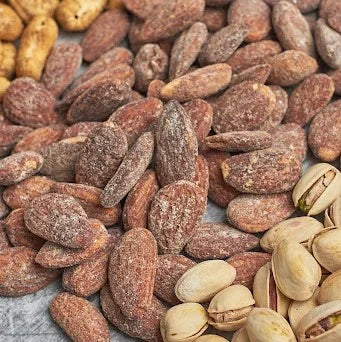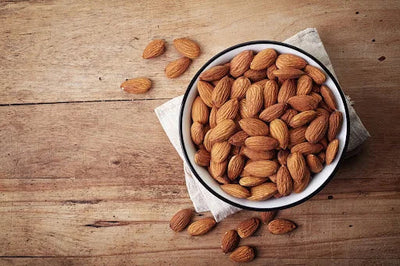Dry roasting is a process that not only enhances the flavor and aroma of nuts, but also improves their texture and shelf life. At Nutnut, we use artisanal techniques to roast nuts in small batches, ensuring a fresh and delicious product. Explore how dry roasting takes your favorite snacks to the next level!
What does roasting contribute to nuts?
He dry roasting It is a process that significantly transforms the characteristics of nuts, improving their flavor, aroma, texture and preservation.
The heat applied during dry roasting causes a series of chemical reactions that enhance the profile of flavor of nuts. In addition, volatile compounds are generated that enhance the scent characteristic of nuts, giving them a deeper, more appealing scent. The evaporation of internal moisture causes nuts to become More crunchy , offering a more satisfying bite and a firmer texture compared to raw nuts. Finally, their shelf life is improved by removing some of the moisture. Dry roasting helps prevent oxidation of natural oils, extending the product's shelf life without the need for preservatives.
Can you perceive the roasting in the flavor of the nuts?
Definitely! Dry roasting enhances the natural nuances of each nut, giving them a more intense, deeper, and balanced flavor. The absence of added oils allows the palate to more clearly perceive the unique characteristics of each variety, resulting in a purer, more authentic, and delicious snack.
What organoleptic changes occur during roasting?
During the dry roasting With coarse salt, nuts undergo a series of organoleptic changes that affect their flavor, aroma, texture and color.
1. Flavor
Dry heat activates a series of chemical reactions that intensify the natural flavor of nuts:
- Maillard Reaction : This process occurs between the amino acids and natural sugars of the dried fruit, developing toasted, caramelized and more complex notes.
- Release of natural oils : When heated, nuts release their essential oils, enhancing their flavor without the need for additional fats.
- Interaction with coarse salt : The salt adheres to the surface and penetrates slightly into the dried fruit due to the residual moisture, highlighting the nuances of flavor without masking them.
2. Aroma
Dry roasting generates volatile compounds that intensify the characteristic aroma of nuts. These compounds are responsible for the appealing roasted nutty smell.
3. Texture
The evaporation of moisture makes the nuts crispier and firmer . Coarse salt helps remove some of the surface moisture, contributing to a crispier texture.
4. Color
The heat causes a gradual darkening , resulting in golden or toasted brown tones, visually associated with perfect toasting.
Dry roasting with coarse salt enhances the flavor, highlights the aromas, improves the texture, and enhances the color of the nuts, without the need for added oils.
What temperatures and times are ideal for each type of nut?
He dry roasting of nuts varies depending on the type of fruit, as each has its own characteristics in terms of moisture and composition. ideal temperatures and times for each type of dried fruit varies to obtain the best result in terms of flavor, texture and quality.
It depends on the nut, temperatures vary between 160 ºC and 200 ºC and cooking time between 12 and 30 minutes per batch.
How does roasting affect digestibility?
He toasted of nuts can have several effects on the digestibility of these, since the roasting process alters both their structure and chemical composition. These are the main factors influenced by roasting:
- Improves digestibility by reducing antinutritional compounds.
- Improves digestive tolerance : Dry roasting does not introduce additional fats, making nuts easier to digest for people with digestive sensitivities or gastrointestinal problems.
In short, roasting improves the digestibility of nuts by reducing antinutrients, softening proteins, and making natural oils more accessible.
What roasting methods are there (oven, pan, industrial)?
There are several roasting methods for nuts, each with its own characteristics and benefits.
1. Oven roasting
It is one of the most common methods and consists of roasting the nuts in a conventional oven .
- Advantages: Precise temperature control, allowing for even roasting. Ideal for large batches.
- Process: The nuts are placed on a tray and exposed to direct heat at temperatures typically between 150°C and 180°C for 10 to 20 minutes.
2. Pan-toasting
This is a more method homemade and quick , in which the nuts are roasted directly in a pan over medium heat.
- Advantages: Complete control over the process and flavor, since you can stir the fruits to prevent them from burning.
- Process: The nuts are placed in the pan without oil or with a small amount of oil and stirred constantly until they reach the desired toasted color. This is best for small batches.
3. Industrial roasting
This is the method used in large factories and for the mass production of roasted nuts.
- Advantages: Allows processing of large volumes of nuts quickly and efficiently.
- Process: They are used industrial toasters with continuous belts and hot air. These methods are designed to ensure uniform roasting and precisely control humidity and temperature.
Are all nuts roasted?
Not all nuts are roasted, although most are to improve their flavor, texture, and preservation. Some nuts are consumed raw or simply dehydrate to preserve its natural properties.
Nuts that are usually roasted:
- Almonds : They are roasted to intensify their flavor and make them crunchier.
- Peanuts : They are usually roasted to improve their flavor and increase their shelf life.
- Hazelnuts : They are roasted to enhance their flavor and make it easier to remove the shell.
- Cashews : They are roasted to improve their flavor and texture.
- Pistachios : They are roasted to open the shell and enhance their flavor.
Nuts that are not always roasted:
- Nuts : Although they can be roasted, they are generally eaten raw to keep their oils and nutrients intact.
- Pine nuts : They are eaten fresh, but are sometimes briefly toasted for use in certain recipes.
- Macadamias : Although they can be roasted, they are often sold raw due to their natural flavor and texture.
Why are some nuts not roasted?
Roasting can alter the nutritional profile and flavor of some nuts, so in some cases, it is preferable to keep them raw to preserve all their benefits.
Most nuts are roasted for reasons of flavor and conservation, but there are exceptions depending on the type of fruit and consumer preference.
How do we roast nuts?
Our dry roasting technique is an artisanal process using a rotating drum, where we roast in small batches by hand to ensure the freshness and perfect roasting of each product.
We invite you to discover our entire range of roasted nuts and discover these unique flavors.






Leave a comment
This site is protected by hCaptcha and the hCaptcha Privacy Policy and Terms of Service apply.